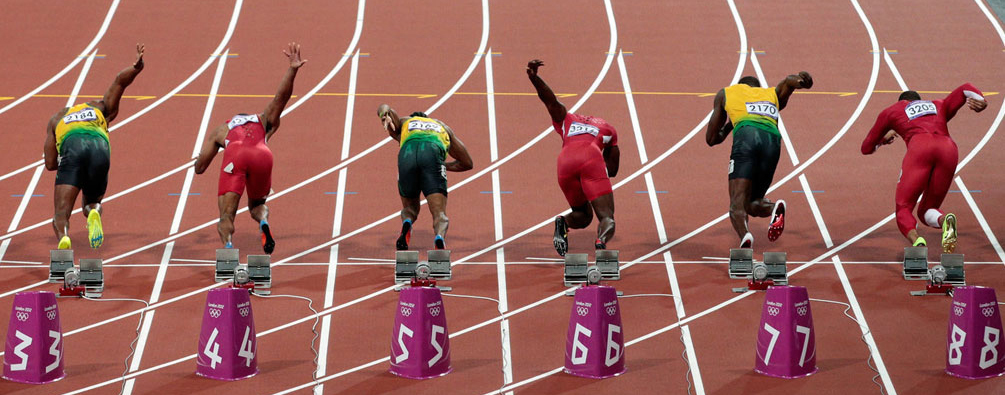Athletics in Teso College Aloet
Teso College hosts inter-house athletics competitions on College Sports Day with the students‘ enthusiastic participation. TCA also competes at the district level with good results. The administration recognizes excellence in the sport and supports a high level of training and coaching.
Read more about recent Teso College athletics meets at the Hub.
Athletics
Athletics, also known as track and field, is a sport made up of various contests in running, jumping and throwing. It is one of the world‘s oldest sports, being played at the original Olympic Games in ancient Greece. Athletics competitions are called meets and are usually held outdoors, with the running events taking place at an oval about 440 yd long. The field events (jumping and throwing competitions) usually take place at the same time, on the area inside the track or nearby.
Running Events
Sprinting
Sprints are races over relatively short distances (up to 400 meters) in lanes around the track and require running with sustained speed. The sprinters begin from a crouched starting position, with both hands and both feet on the track. In order to ensure equal running distances, they have staggered starting positions, spaced further up the track depending of the placement of their lane relative to the inside edge.
Middle-distance running
Middle-distance running consists of races over distances 800 to 3,000 meters, with the one-mile race also included. The runners begin from a standing start along a curved starting line. These races demand strong speed endurance from the athletes. It is important that they are able to pace themselves so that they don‘t run out of energy before they are able to complete the race.
Long-distance running
Long-distance races are held over distances of 3,000 meters and up, with the marathon, at 26.22 miles (42,186 meters) being the most well-known. Other long-distance events are the steeplechase, cross-country, and road runs. The steeplechase combines long-distance running with hurdling, each runner being required to clear seven water jumps and 28 hurdles in a 3,000-meter course. The most important skills needed for long-distance running are endurance and pacing.
Relays
Relay races are held between teams of 4 members each. Each racer runs 25% of the race while carrying a small stick called a baton that he passes to the next team member when his turn is done. The standard relay races are 4 legs of 100 meters each (400 meters total) and 4 legs of 400 meters each (1,600 meters total). The ability to coordinate at speed to pass the baton well is crucial in the shorter relays, so time is not wasted.
Hurdling
Hurdling combines running and jumping, since the race is run while jumping over a series of obstacles called hurdles, which are 36 to 42 inches high depending on the race. These races are run in lanes, and the hurdler may knock over his hurdles as long as he doesn‘t leave his lane or push over the hurdles with his hands. The object is to make the hurdling action smooth and rhythmic so as not to disrupt the forward run. The most common hurdling events are the 110-meter and 400-meter races.
Jumping Events
High jump
The object of the high jump is to clear a bar that is placed across two standards and raised as the event progresses. The jumper takes a short running start and must leave the ground from one foot only in order to attempt to clear the bar. As long as he doesn‘t have three consecutive misses he may stay in the competition. The landing pit is inflated or padded with foam rubber in order to reduce injury.
Pole vault
In this event the vaulters attempt to clear a high bar (similar to a high jump bar, but set higher) with the aid of a pole. The vaulter takes a running start over 150 ft while carrying the pole. When he nears the bar he plants the pole in the metal box placed before the bar for that purpose and jumps, pulling himself up the pole until he is almost doing a handstand on it. He twists as he nears the crossbar and arches over it feet first and facedown, landing in a padded pit.
Long jump
In the long jump (formerly called the broad jump), the jumper takes a running start, plants a foot on the takeoff board, and leaps into the air. A legal jump requires that no part of the forward foot extend beyond the board. The most popular long-jumping style is called the “hitch-kick, in which the runner seemingly walks in air.
Triple jump
The triple jump requires its contestants to hop, step, and jump into the pit. When the athlete reaches the board, he takes off and lands on the same foot. Then, while attempting to maintain momentum, the athlete takes an exaggerated step, landing on the opposite foot, and then continues into the pit with a third jump, landing with both feet.
Throwing Events
Shot put
The shot put involves throwing a 16-lb metal ball as far as possible from within a 7 ft circle. The event is called the ‘shot‘ put because in the 17th century round cannon ammunition, or ‘shot‘, was used.
Discus
The discus throw was one of the events in the ancient pentathlon, dating back to 708 BC. The discus is a plate-shaped object 4.4 lb in weight and 8 inches in diameter. It is thrown from within a 2.5 meter square throwing area.
Hammer
The hammer throw is a very old sport dating back to 1800 BC. In 16th century England actual blacksmith‘s hammers were thrown, but the modern ‘hammer‘ used for this event is a metal ball weighing 16 lb attached to a chain 3 ft in length. The athlete spins with the hammer in a circle before releasing it to attain the greatest distance.
Javelin
The javelin throw is one of the oldest athletic events of all, with prehistoric origins. The modern javelin throw involves throwing a spear about 8 ft 6 in long weighing about 1.8 lb. The object is to obtain the greatest possible distance from a short running start before releasing the javelin.




